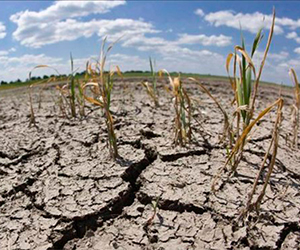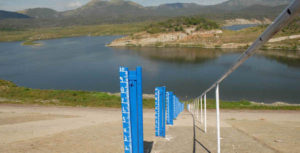CUBA SUFFERS DESPERATE SITUATION WITH DROUGHT AFFECTING THE ISLAND.
At least 239 sources of water in Cuba today are affected by the drought, according to a report by the National Institute of hydraulic resources (INRH). Of that number of sources of supply of the liquid, 191 are partially affected and 48 total way, is indicated in the text, in the headquarters of the INRH, in Havana.
To inform the hydrological situation in the country at the end of August and until so far in September, the director of that agency, José Antonio Hernández, rational use of water also said that the Santiago de Cuba province, belonging to the eastern area, is the most hit, having 51 of those systems affected by drought.
In Santiago, who has water has power.
The city suffers from as few drought plaguing the island. The water, pumped up by the aqueduct of the city from dams, becomes houses every fifteen or twenty days. It is a mess. In the streets one note the hustle, the constant struggle to fill a jug, a tank or simply some water knobs.
To make matters worse, the Guaos River, which flows through a part of the city, is a green and smelly swamp. And people can not pick up water from it already. The Guaos for a long time he saved the Santiago, now a filthy. Wastes from the textile company (headquarters of the textile industry in the province) and slaughterhouse have ended it infest. In addition, in recent years unhealthy citadels have risen about from there forming small floating populations who have taken to the River as their particular waste tank or the bathroom that they have in their homes of cardboard and rotten wood.
“It doesn’t rain. The dam is on the floor. We are below the minimum level, it is a critical situation,”said Eugenio Frómeta, employee of the dam stop, one of the most important in the city for its 34 million cubic meters of capacity.
With water scarcity, the families possessing natural wells that runs some spring in its properties have become powerful families. All Santiago depend on them. There are several wells throughout the city, in the suburbs mainly. Drought and lack of water in the houses has generated big business for those few who have had the luck to be blessed by mother nature.
People visit it en masse. Avenues go carts horses with three or four tanks of 50 litres, also pass trucks and trucks, people walk, people bicycle, with knobs and cubes to slopes, either for personal consumption or for resale then the water in the most remote communities or those who live nearby and do not have time to get to the well to ensure the daily consumption.
What in Havana are the Carters, hawkers of food, fruits and vegetables, in Santiago are the “omens”: water vendors who are trumpeting across the street with horse carts filled with any type of container used to store. There is no more secure sale is: water in drought. Business round.
“The tank is worth two Cuban pesos, almost gift them to people.” People then resell that same tank to 1 CUC. Chariots charging them 60 pesos for scour”, says Francisco, owner of the well of the most famous of all Santiago, while it guarece the Sun of noon under the bridge of Marimon, at the end of the Avenue of the Americas.
Francisco is a black, purple. Your denture is a puzzle that missing parts up and down, and when it opens and closes the mouth seem like molar teeth the gingiva is desencajaran you.
“The State wants to provide free water and I told them that no, that this was my business.” Francisco looking four meters of depth of the well is that only the electric pump up water from the earth I can ends meet between 600 and 700 pesos of consumption,”says.
From the mouth of the well, the darkness is total. No you can see almost nothing, just a piece of old cardboard which seems to float in the air and some leaves of trees around.
“Those leaves always arise and fall, pick up them once a day because the inspectors will not let me live, me are always reviewing the State of the water and the hygiene of the well.” In the end, I am not guilty of the drought but in this country the chain always breaks at the weakest,”says Francisco.
Agencies/Univision/Abraham Jimenez/Excerpts/Internet Photos / Arnoldo Varona / TheCubanHistory.com
THE CUBAN HISTORY, HOLLYWOOD.
FOLLOW US ON TWITTER AND FACEBOOK. THECUBANHISTORY.COM
SUFRE CUBA DESESPERADA SITUACIÓN CON LA SEQUÍA.
Al menos 239 fuentes de abasto de agua en Cuba están afectadas hoy por la sequía según un informe del Instituto Nacional de Recursos Hidráulicos (INRH). De esa cifra de fuentes de suministro del líquido, 191 están afectadas parcialmente y 48 de forma total, se indica en el texto, presentado en la sede del INRH, en La Habana.
Al dar a conocer la situación hidrológica del país al cierre de agosto y hasta lo que va de septiembre, el director de Uso Racional del Agua de ese organismo, José Antonio Hernández, precisó además que la provincia de Santiago de Cuba, perteneciente a la zona oriental, es la más golpeada, al tener 51 de esos sistemas perjudicados por la sequía.
EN SANTIAGO, QUIEN TIENE AGUA TIENE PODER.
La ciudad padece como pocos la intensa sequía que azota a la isla. El agua, bombeada por el acueducto de la ciudad desde las presas, llega a las casas cada quince o veinte días. Es un caos. En las calles uno nota el ajetreo, la lucha constante por llenar un garrafón, una tanqueta o simplemente unos pomos de agua.
Para colmo de males, el río Los Guaos, que atraviesa una parte de la ciudad, es un pantano verde y apestoso. Y la gente ya no puede recoger agua de él. Los Guaos por mucho tiempo salvó a los santiagueros, ahora es una inmundicia. Los desechos de la Textilera (sede de la industria textil de la provincia) y el Matadero lo han terminado de infestar. Además, en los últimos años ciudadelas insalubres se han levantado cerca de allí formando pequeñas poblaciones flotantes que han tomado al río como su tanque de basura particular o como el baño que no tienen en sus casas de cartón y madera podrida.
“No llueve. La presa está en el piso. Estamos por debajo del nivel mínimo, es una situación crítica”, dice Eugenio Frómeta, trabajador de la presa Parada, una de las más importantes de la ciudad por sus 34 millones de metros cúbicos de capacidad.
Con la escasez de agua, las familias que en sus propiedades poseen pozos naturales por los que corre algún manantial se han vuelto familias poderosas. Todos en Santiago dependen de ellos. Hay varios pozos por toda la ciudad, en las afueras principalmente. La sequía y la falta de agua en las casas ha generado un gran negocio para los pocos que han tenido la suerte de estar bendecidos por la madre natura.
La gente acude en masa. Por las avenidas pasan las carretillas de caballos con tres o cuatro tanques de 50 litros, pasan también carros y camiones, gente a pie, gente en bicicleta, con pomos y cubos a cuestas, ya sea para su consumo personal o para revender luego el agua en las comunidades más lejanas o a los que viven cerca y no tienen tiempo de llegarse hasta el pozo para garantizar el consumo diario.
Lo que en La Habana son los carretilleros, vendedores ambulantes de viandas, frutas y vegetales, en Santiago son los “agüeros”: vendedores de agua que van pregonando por toda la calle con las carretillas de caballo repletas de cualquier tipo de envase que sirva para almacenar. No hay venta más segura esta: agua en sequía. Negocio redondo.
“La tanqueta vale dos pesos cubanos, casi se las regalo a la gente. Después esa misma tanqueta la gente la revende a 1 CUC. A los carros les cobro sesenta pesos por el fregado”, dice Francisco, dueño del pozo más famoso de todo Santiago, mientras se guarece del sol del mediodía debajo del puente de Marimón, al final de la avenida de las Américas.
Francisco es un tipo negrísimo, color púrpura. Su dentadura es un rompecabezas al que le faltan piezas arriba y abajo, y cuando abre y cierra la boca parece como que se le desencajaran los molares de la encía.
“ El Estado quiere que brinde gratis el agua y les dije que no, que este era mi negocio. Es que solo la bomba eléctrica para subir el agua de la tierra me cuesta a fin de mes entre 600 y 700 pesos de consumo eléctrico”, dice Francisco mirando los cuatro metros de profundidad del pozo.
Desde la boca del pozo la oscuridad es total. No se puede distinguir casi nada, solo un pedazo de cartón viejo que parece flotar en el aire y algunas hojas de árboles alrededor.
“Esas hojas siempre se desprenden y caen, las recojo una vez al día porque los inspectores no me dejan vivir, siempre están revisándome el estado del agua y la higiene del pozo. Al final, yo no soy el culpable de la sequía pero en este país la cadena siempre se rompe por el eslabón más débil”, dice Francisco.
Agencies/Univision/Abraham Jiménez/Extractos/Internet Photos/ Arnoldo Varona/ TheCubanHistory.com
THE CUBAN HISTORY, HOLLYWOOD.








